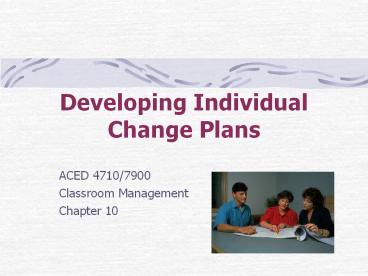Developing Individual Change Plans PowerPoint PPT Presentation
1 / 12
Title: Developing Individual Change Plans
1
Developing Individual Change Plans
- ACED 4710/7900
- Classroom Management
- Chapter 10
2
Topics
- Introduction
- Behavior Management in Perspective
- Conducting An Environmental Analysis/Functional
Assessment - Strategies for Helping Students Develop New
Behavioral Skills - A Team Approach to Developing a Positive Behavior
Change Plan - Conclusion
3
Introduction
- Teachers are increasingly asked to successfully
incorporate into their regular education
classrooms students who have difficulty behaving
in ways that facilitate their own learning and
the learning of others. - During the 1990s, there occurred a shift away
from a simple focus on rewards and punishments
towards an approach termed cognitive behaviorism
in which educators emphasized helping students
better understand their behavior and take greater
responsibility for changing their behavior. - Self monitoring
- Self instruction
- Social skill training
4
Behavior Management in Perspective
- Basic assumptions
- Behaviorism is a scientific approach to changing
behavior. - Behavior is influenced by the consequences
following the behavior. - Behavior change programs must focus on specific,
observable behavior. - Data collection is necessary in order to alter
behavior thoughtfully and systematically.
5
Behavior Management in Perspective (continued)
- Advantages to Behavior Management
- Some students need special assistance in
controlling their behavior. - Reinforcers and response cost can assist students
in developing more productive behaviors. - Behavioristic intervention may have a positive
effect on other students in the classroom,
whereas reprimands often create a negative ripple
effect.
- Disadvantages to Behavior management
- Causes the teacher to focus on students behavior
rather than on his/her teaching methods. - When too much external control (rewards) is used,
it may have a negative effect on students
ability to become competent and positive
individuals.
6
Conducting an Environmental Analysis/Functional
Assessment
- A Functional Assessment Involves 4 Components
- A functional assessment
- A positive behavior change plan
- The implementation of this plan
- The ongoing monitoring and adjustment of this
plan
7
Conducting an Environmental Analysis/Functional
Assessment (Continued)
- A Functional Behavioral Assessment Answers the
Following Questions - What are the antecedents and the consequences
that cause the behavior to exist? - What function(s) does the behavior serve for the
student? - What environmental changes can be made to change
the students behavior? - What behaviors can we teach the student to help
him act more responsibly and meet his needs
without using behaviors that violate the rights
of others?
8
Conducting an Environmental Analysis/Functional
Assessment (Continued)
- How is it conducted
- Can be completed by indirect methods, such as
interviewing parents, counselors, administrators,
and instructional assistants. - Can be completed by direct methods, such as
actual classroom observation by a peer teacher,
an administrator, and the misbehaving student. - Should be implemented by teams.
- Should be viewed as a proactive strategy rather
than a reactive. - See page 365 of our text for an example of an
observation form.
9
Strategies for Helping Students Develop New
Behavioral Skills
- Self-Management
- Help students count and record their own
behavior. - Teach students new social skills for meeting
their needs. - Develop an agreement or contract to help motivate
students to use those new skills.
- Self-Monitoring
- Assist students in establishing a system for
recording their own behavior. - This creates an internalized locus of control.
- This approach carries over to other situations
and other behaviors.
10
A Team Approach to Developing a Positive Behavior
Change Plan
- An effective team should be comprised of two
classroom teachers who work with the student, a
counselor, an administrator, a parent, and the
student. - The team should focus on no more than two
behaviors. - The team should develop no more than three
interventions for each behavior. - See page 402 in our text for an example of a
change plan.
11
Contracts are sometimes used to alter students
behavior. These contracts
- May be for individuals or groups.
- Should have buy-in from all affected parties
for maximum effect. - Should specifically address expected behaviors
and rewards/consequences. - Work best when geared toward rewards (positive
reinforcement) rather than punishment. - Are explained beginning on page 389 in your text.
12
Conclusion
- Teachers can dramatically influence student
behavior. - We increasingly are asked to document both
student behavior problems and the interventions
used to alter the misbehavior.
- The ability to help these students is
professionally rewarding.
See Activity 4.2 for an assignment related to
this topic.

